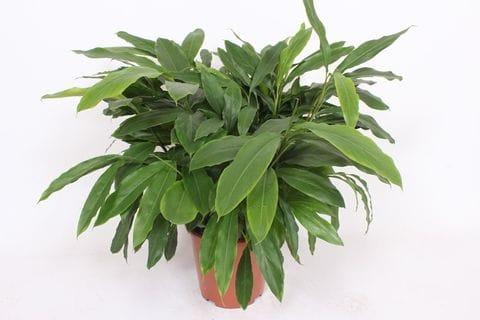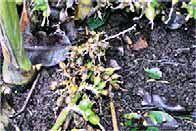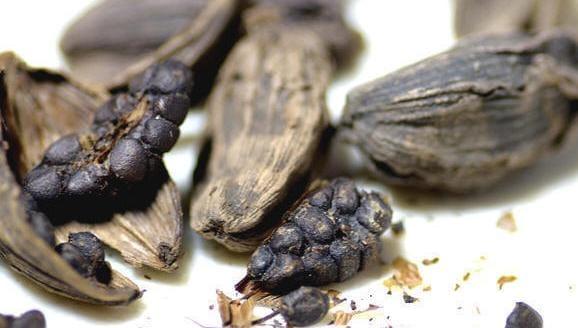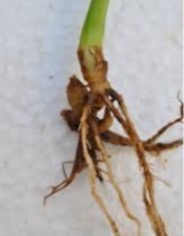Elaichi Plant
Elachi, possibly referring to Cardamom, is a spice plant. Plant in well-draining soil and partial shade. Keep the soil consistently moist, and provide humidity. Fertilize during the growing season for optimal spice production. Prune to remove dead or yellowing leaves.

Habit
Herb
Height
1.0-2.0 m
Growth
Slow
Soil
Well Drained, Loamy
Shade
Partial shade to Full Sun
Moisture
Moist
Edible
Yes
Medicinal
Yes
Origin
India, Sri Lanka
Climatic Condition
Tropical
Temperature (°)
20-30°C
Humidity (%)
60-80%
Potting media
Garden soil
Fertilizers
Organic compost
Watering
Regular watering; prefers moist soil
Plant Weight
1-2 kg
Flowering Time
Year-round
Soil Ph level
6.0 - 7.5
Water Ph level
6.0 - 7.0
Soil EC
0.4 - 0.6
Yield Per Plant
(Elaichi) plant can produce about 1–2 kilograms
NPK ratio
20:10:10
life Span
Perennial
Health Benefits
Used in cooking; medicinal properties
Suggested Grow Media or Potting Mix ?
50% loamy soil, 30% compost, 20% sand
Suggested Fertigation/Fertilizers
Fertilize every 4 weeks with a balanced fertilizer.
Common Diseases and Remedies
Clamp rot , Capsule rot .
Leaves become pale yellow , Grey patches .
Remove diseased clumps , Burning of field .
What Is An Elaichi Plant?
An elaichi plant refers to the plant that produces cardamom, a popular spice known for its strong, aromatic flavor. The plant belongs to the ginger family and typically grows in tropical regions. It produces small, green seed pods that contain the seeds known as cardamom pods, which are used in cooking, baking, and beverages.

What are the different types of Elaichi plant?
1. Green Cardamom (Elettaria cardamomum) :-
This is the most common type of cardamom and is also known as true cardamom or small cardamom. It is native to India and is widely cultivated in other tropical regions such as Guatemala, Sri Lanka, and Tanzania. Green cardamom pods are small and light green in color, containing small black seeds. They have a strong, aromatic flavor and are used in both sweet and savory dishes.
2. Black Cardamom (Amomum subulatum):-
Also known as large cardamom or brown cardamom, black cardamom is native to the eastern Himalayas and is primarily grown in India, Bhutan, and Nepal. The pods are larger and darker in color compared to green cardamom, with a smoky, resinous flavor. Black cardamom is commonly used in savory dishes, particularly in Indian and Tibetan cuisines, to impart a distinct earthy flavor.
3. Malabar Cardamom (Elettaria cardamomum var. major):-
This variety is native to the Western Ghats of southern India and is known for its high quality and intense flavor. It is the most widely cultivated type of green cardamom.
4. Mysore Cardamom (Elettaria cardamomum var. miniscula):-
Also native to southern India, this variety is smaller in size compared to Malabar cardamom but is highly aromatic.
5. Siam Cardamom (Amomum krervanh):-
Grown in Southeast Asia, particularly in Thailand and Cambodia, this variety has a distinct aroma and flavor profile compared to other types of cardamom.
How to care for an elaichi (cardamom) plant?
1.Location:
For growing elaichi (cardamom) plants, choose a location that provides the warmth conditions . Select a spot that receives bright, indirect sunlight. Cardamom plants thrive in warm temperatures ranging between 70-90°F (21-32°C). Avoid placing them in direct sunlight, especially during the hottest part of the day, to prevent leaf burn.
2.Sunshine:
Elaichi (cardamom) plants prefer bright, indirect sunlight. They thrive when placed in locations where they receive ample natural light but are shielded from direct sunlight, especially during the hottest part of the day. Bright, indirect sunlight helps promote healthy growth and development without risking leaf burn or sun damage. Placing the plant near a window with sheer curtains or in a location with filtered sunlight provides the ideal balance of light intensity for optimal growth.
3.Soil:
For elaichi (cardamom) plants, use a well-draining, rich potting mix with plenty of organic matter. A good soil mixture typically consists of equal parts peat moss, perlite, and compost. This combination ensures proper drainage to prevent waterlogging, while also providing essential nutrients for the plant's growth. Additionally, the organic matter in the soil helps retain moisture and promotes healthy root development.
4.Hydration:
Hydration for elaichi (cardamom) plants involves keeping the soil consistently moist but not waterlogged. Water the plant when the top inch of soil feels dry to the touch, typically every 1-2 days depending on environmental conditions like temperature and humidity. When watering, thoroughly moisten the soil around the plant, allowing excess water to drain freely from the bottom of the pot to prevent waterlogging.

5.Nourishment:
Feed the plant regularly during the growing season (spring and summer) with a balanced liquid fertilizer diluted to half strength. Apply fertilizer once a month to replenish nutrients in the soil and promote vigorous growth. Reduce fertilization frequency in fall and winter when the plant's growth slows down. Incorporate organic matter into the soil to enrich its nutrient content and improve soil structure. Compost or well-rotted manure can be mixed into the soil or applied as a top dressing to provide a slow-release source of nutrients over time. Ensure the plant receives micronutrients like iron, manganese, and magnesium, which are essential for overall plant health and productivity. Consider using a balanced fertilizer that includes these micronutrients or supplement with micronutrient-rich amendments as needed. Monitor the soil pH and adjust it if necessary to maintain a slightly acidic to neutral pH level (around 6.0 to 7.0). Cardamom plants prefer slightly acidic soil conditions for optimal nutrient uptake and growth.
6.Issues:
Excessive moisture can lead to root rot and fungal diseases. Ensure proper drainage and allow the soil to dry out slightly between waterings. Insufficient watering can cause the plant to wilt and dry out. Maintain consistent soil moisture, especially during hot weather or when the plant is actively growing. Cardamom plants may be susceptible to pests such as aphids, spider mites, and whiteflies. Monitor the plant regularly and treat infestations promptly with insecticidal soap or neem oil. Fungal diseases like root rot and leaf spot can occur in overly moist conditions or if the plant is overcrowded. Improve air circulation and avoid overhead watering to prevent fungal issues. Yellowing leaves or stunted growth may indicate nutrient deficiencies. Ensure the plant receives adequate fertilization and micronutrients to support healthy growth.
What are the benefits of the elaichi plant?
The elaichi (cardamom) plant offers several health benefits:
1. Digestive Aid
2. Freshens Breath

FAQS about growing Elaichi plant
1. When and how do you harvest elaichi pods?
Wait until the elaichi pods are fully mature and have turned from green to yellow or brown, depending on the variety. Mature pods will also develop a slightly wrinkled appearance. Use sharp pruning shears or scissors to carefully cut the mature pods from the plant's stems. Snip the pods off close to the base of the stem to avoid damaging the plant. Harvest elaichi pods as they reach maturity, rather than waiting for the entire crop to ripen at once. This allows for continuous harvesting throughout the growing season.
2.How long does it take for elaichi plants to start producing pods?
Elaichi (cardamom) plants typically take about two to three years to start producing pods after they are planted from seeds or transplanted as rhizomes. However, this timeframe can vary depending on various factors such as growing conditions, plant variety, and care practices. Generally, it's important to provide consistent care, including proper watering, fertilization, and adequate sunlight, to encourage healthy growth and early pod production.
3.How do you prune and maintain elaichi plants for optimal growth?
Remove Dead or Yellowing Leaves: Regularly inspect the plant for dead or yellowing leaves and remove them promptly. This helps improve air circulation and prevents the spread of diseases. If the plant becomes leggy or overgrown, prune back the stems to encourage bushier growth. Use sharp, clean pruning shears to trim back stems to a desired length, making cuts just above a leaf node. Keep the area around the plant free of weeds, as they can compete with the elaichi plant for nutrients and water. Remove weeds by hand or use mulch to suppress weed growth.
4. What are some culinary uses for elaichi pods besides traditional spice usage?
Add elaichi pods to teas, coffees, or hot chocolates to infuse them with a delicate and aromatic flavor. Simply crush the pods slightly before adding them to the hot liquid. Incorporate ground or crushed elaichi pods into baked goods such as cakes, cookies, muffins, and bread for a subtle yet distinctive flavor. Elaichi pairs well with ingredients like chocolate, citrus, nuts, and fruits. Use elaichi pods to flavor desserts such as custards, puddings, ice creams, and sorbets. Infuse milk or cream with elaichi pods before incorporating them into dessert recipes for a fragrant twist. Add crushed elaichi pods to smoothies, fruit juices, or lassis (Indian yogurt drinks) for a refreshing and aromatic flavor boost. Elaichi pairs well with fruits like mango, banana, strawberry, and pineapple.
5. Are there any traditional medicinal uses for elaichi plant?
Yes, elaichi (cardamom) has been used in traditional medicine systems for various medicinal purposes. Some traditional medicinal uses of elaichi include:
1. Digestive Aid
2. Respiratory Support
3. Antimicrobial Properties
4. Oral health
5. Anti-inflammatory
6. Cardiovascular Health
7.Stress Relief



